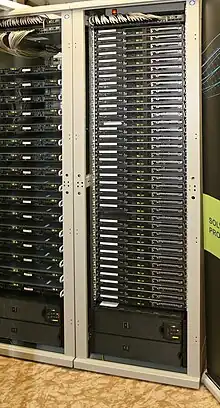Amalka Supercomputing facility
The Amalka Supercomputing facility[1] is the largest of the three Czech parallel supercomputers.[2] It is used by Department of Space Physics, Institute of Atmospheric Physics, Academy of Sciences of the Czech Republic.

The primary task is computation[3] and visualisation in the area of space research for the European Space Agency or NASA, such as a preparation of Demeter (satellite) launch.
Amalka Supercomputing facility is credited with computing the first kinetic magnetic field model of Mercury in the MESSENGER project.[4] It also helped to understand the results from the Cluster II mission.[5]
At present, the facility is supporting the THEMIS (Time History of Events and Macroscale Interactions during Substorms) project. The results will be useful in planning for creating permanent human bases on Moon that will be protected from solar wind.
The current version runs Linux slackware and delivers 6.38 TFlops. Expansion and optimization of the infrastructure is being implemented by Sprinx Systems.
| Generation | Year | Processing Rate | # of Computers | # of CPUs | # of Cores | Other parameters |
|---|---|---|---|---|---|---|
| 1 | 1998 | units of MFlops | 8 | 8 | 8 | |
| 2 | 2000 | tens of GFlops | 16 | 16 | 16 | |
| 3 | 2003 | around 1 TFlop | 96 | 188 | 188 | |
| 4 | 2006 | 2,6 TFlops | 138 | 272 | 360 | 180 GB RAM, 20 TB HDD, 40 kW |
| 5 | 2007 | 4,07 TFlops | 326 | 572 | ||
| 6[6] | 2009 | 6,38 TFlops | 356 | 800 |
References
- "Amalka Supercomputing facility homepage". Archived from the original on 3 August 2009.
- I am Amálka, the most powerful supercomputer in the Czech Republic (Google Translation from Czech)
- Mirror structures above and below the linear instability threshold: Cluster observations, fluid model and hybrid simulations
- http://terezka.ufa.cas.cz/shs/amalka4/index.html%5B%5D MESSENGER: Exploration of Mercury's magnetosphere
- "UNH Experimental Space Plasma Group". Ssg.sr.unh.edu. Retrieved 2016-04-09.
- "– photos from the 6th generation launch". Archived from the original on 2009-11-25. Retrieved 2009-11-12.